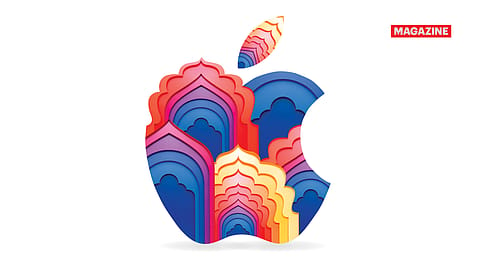Apple Can’t Afford to Ignore the India Market. Here’s Why
India and Apple have grown to share a special bond, despite the country’s relatively low contribution to the company’s top line. A look at why and what’s next.

This story belongs to the Fortune India Magazine global-brands-indian-sheen issue.
FOR APPLE FANS in India, September 9 every year means a late-night ritual of seeing Tim Cook say his signature “good morning” from Apple Park in Cupertino, California, as he unveils the latest iPhones.
But this year’s event was about more than just devices. Apple timed it with the next phase of its India retail push. Just a week before the September launch, Apple opened its first official stores in Pune and Bengaluru. It had a store in Mumbai and Delhi.
Where does India fit into Apple’s global playbook, and what comes next in this growing courtship?
Will Apple find more buyers in India?
Apple is betting on it: This year, it unveiled four models of the iPhone 17 series, with a more powerful base model, the iPhone Air, iPhone 17 Pro, and Pro Max. The base model starts at ₹82,900, featuring a 48MP Main Fusion Ultra-Wide camera.
Aside from the iPhones, Apple launched upgraded Watch collections with SE 3, Ultra 3, and Watch 11 series, and ANC-focussed AirPods Pro 3.
Navkendar Singh, AVP of International Data Corporation’s India unit, says a little more than half of Apple’s India sales come from iPhones, primarily the model just below the flagship, following major price drops.
More Stories from this Issue
This year, however, the story may be different, with iPhone shipments within India expected to reach 15 million, of which 20-30% could be of the latest basic model, the iPhone 17.
Why? The iPhone 17 is a major upgrade from last year, says Singh. The iPhone 17’s launch also coincides with the replacement cycles of many users, particularly those who purchased the more popular iPhone 15 or earlier versions. Pre-orders are already stocked out.
“We maintain that two-thirds of [15 million shipments] will come from [the iPhone] 16 and 15. India is not a Pro or Pro Max market. The camera is better in iPhone 17, so is the screen and the battery, making iPhone 17 a much better upgrade, which will certainly do better than [the iPhone] 16,” says Singh.
Last year, Apple shipped 12.5 million units and had a 7.58% share of the market in India. “It’s a headline story by any measure, no doubt about it, because Apple operates at about 3X of the average selling price of the market. There is a real possibility that it ends up in the Top 5 for the year 2025 in India,” Singh says.
But does India actually impact Apple?
India accounts for just 5% of global iPhone shipments. A sharp uptick in iPhone sales helped Apple report a 13% growth in India revenues, to $9 billion. Apple’s global portfolio has a turnover of nearly $390 billion. According to Counterpoint Research, 71% of iPhone shipments were from India, and this share will increase, albeit modestly.
IDC’s Singh says India’s contract manufacturers are already gearing up to raise capacity to meet the growth in shipments.
“Apple has to meet the entire U.S. and India demand from India… which means they need to scale up from 40 million to 80 million units…Tata, Pegatron, Foxconn, they are working double time,” he says.
Yet, when Apple has invested heavily in China to build an ecosystem, India can’t become Apple’s China+1, given the supply chain’s dependence on China. Even if shipments from India increase, it does not change the fact that India is a mere final assembly, testing and packaging (FATP) destination.
Singh says India can never replace China. The electronic industry’s supply chain is too dependent on China to decouple effectively from it.
“Our value add is less than 10%. The goal should be to increase this to 15-20% in the next half a decade or so,” Singh says.
So why does India matter? Ignore the 2-3% of global revenue that India accounts for: The double-digit growth in yearly revenue is what piques Apple. Greater China showed negative sales growth for two consecutive years, while emerging markets such as Brazil and South Asia were just building up.
Apple and Cook acknowledge that. This is why Cook has posted about India about 21 times on X compared with just a few times for other emerging markets and even China. This is also why Cook has been very keen on India.
“We’ve announced that we’re going to open four new stores there. The iPhone was the top-selling model in India for the quarter. And it’s the second largest smartphone market in the world, and the third largest for PCs and tablets, and so there’s a huge market. And we have a very modest share in these markets, and so I think there’s lots of upside there,” Cook said in January.
Apple has a quarter of the reseller market share in terms of volumes, which is significantly higher than its single-digit market share of 7% in the direct market in India.
Tarun Pathak, research director, Counterpoint Research, says, “Apple now has the widest portfolio of iPhones ever…. Air is likely to get a lot of mindshare, and we expect a fair share of upgrades on the new 17 series, especially the ones jumping from 14 or older ones,” adds Pathak.
What is next in the plan?
This is why Apple continues to double down on the Indian market, aiming to give consumers the Apple experience. Apple’s new stores are a beachhead in south India. Analysts say north India is tilted towards premium buys. By entering the South around the time it debuted the iPhone 17, it wants to grab the premium market there.
Two more stores in Delhi and Mumbai are expected next. The stores will help Apple by allowing its target market of young professionals to experience its latest innovations.